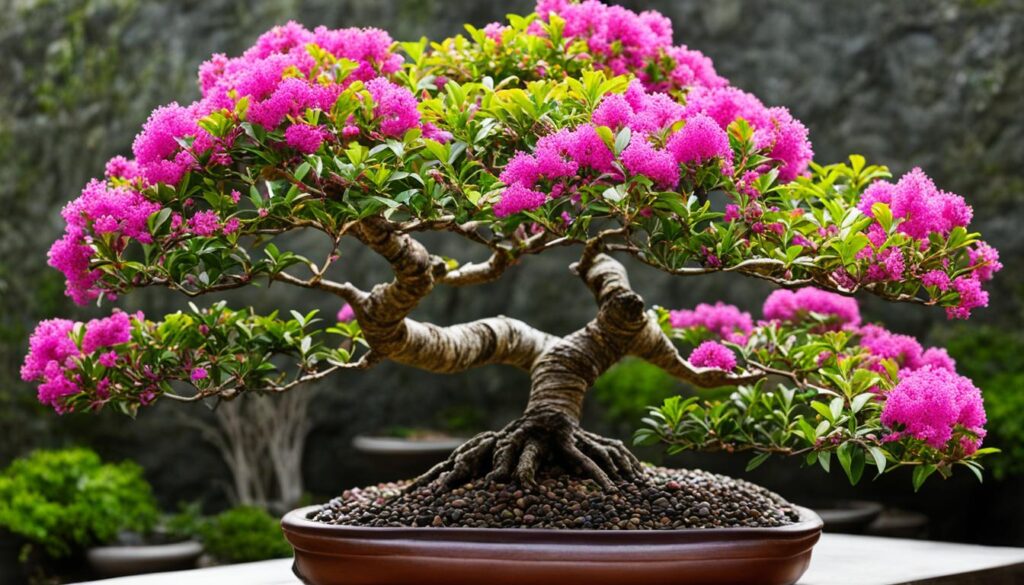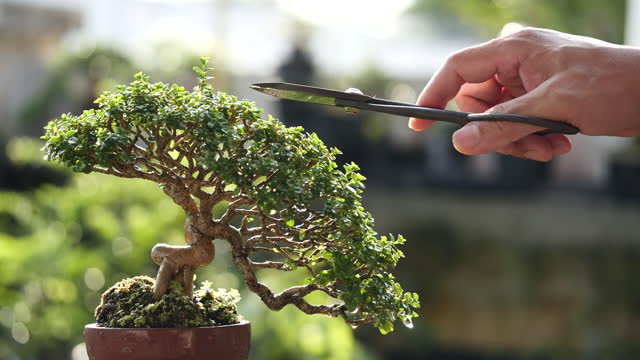If you’re fascinated by the beauty and artistry of bonsai and want to explore the world of crepe myrtle bonsai, you’ve come to the right place. In this guide, we will provide you with all the essential information you need to grow and care for your crepe myrtle bonsai tree.
Crepe myrtle bonsai is a stunning miniature version of the crepe myrtle tree, known for its beautiful flowers and unique features. It is a popular choice among bonsai enthusiasts, offering a captivating combination of delicate foliage, exquisite flowers, and an elegant trunk.
Throughout this guide, we will cover various aspects of crepe myrtle bonsai care, including optimal placement, watering techniques, fertilizing tips, pruning and shaping techniques, repotting essentials, propagation methods, dealing with pests and diseases, and seasonal care tips.
The Unique Features of Crepe myrtle Bonsai
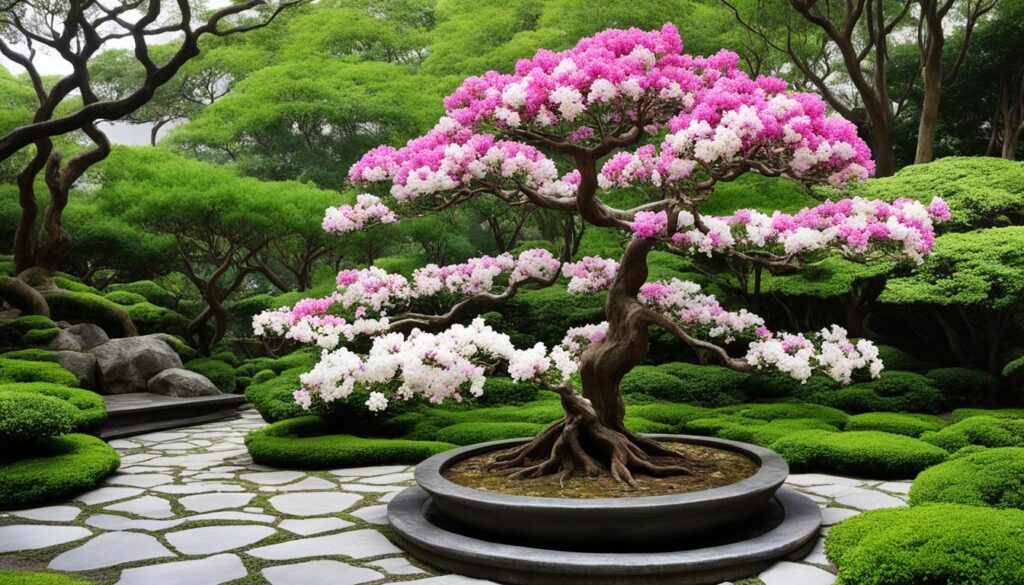
Crepe myrtle bonsai showcases several distinct features that have made it a popular choice among bonsai enthusiasts. Its exquisite flowers, dappled bark, and vibrant autumn foliage make it a visually striking addition to any bonsai collection.
Flowers: One of the standout features of crepe myrtle bonsai is its stunning flowers. These petite trees produce clusters of delicate pink, white, or purple flowers with crinkled petals. The vibrant blossoms add a touch of elegance and charm to the bonsai display.
Bark: The smooth beige dappled bark is another unique characteristic of crepe myrtle bonsai. As the tree matures, the bark gradually peels, revealing a complex texture that adds visual interest to the trunk. The peeling bark creates an intriguing element of natural beauty in the bonsai composition.
Foliage: The oval-shaped leaves of crepe myrtle bonsai add to its overall appeal. During autumn, the leaves undergo a breathtaking transformation, turning vibrant shades of yellow and orange-red. This display of seasonal color adds depth and warmth to the bonsai arrangement.
There are various crepe myrtle varieties available, each with its own unique features and characteristics. Whether you prefer a compact bonsai with smaller flowers or a tree with a more dramatic bark texture, there is a crepe myrtle variety to suit your aesthetic preferences.
Optimal Placement for Your Crepe Myrtle Bonsai

Proper placement is crucial for the health and growth of your crepe myrtle bonsai. By providing the right conditions, you can ensure that your bonsai thrives and flourishes. Here are some considerations for optimal placement:
Benefits of Full Sun Exposure
Your crepe myrtle bonsai thrives in full sun exposure. This means placing it in a location where it receives direct sunlight for at least six to eight hours a day. Full sun exposure encourages abundant flowering and helps prevent common fungal diseases and insect infestations. It also promotes overall tree vigor and healthy growth. Consider placing your bonsai in a spot that receives ample sunlight throughout the day.
Handling Temperate Climates
In temperate climates, it is essential to protect your crepe myrtle bonsai from freezing temperatures during winter. If you live in an area with cold winters, it is recommended to transfer your bonsai to a cool but frost-free location, such as an unheated garage or a greenhouse. This will prevent damage to the tree and ensure its survival during the colder months. Before transferring, make sure to water the bonsai thoroughly and position it in a suitable spot with adequate light.
Winter Care and Positioning
During the winter months, your crepe myrtle bonsai requires specific care to endure the colder conditions. Position it in a place where it will receive sufficient light, such as a south-facing window or under grow lights. Be mindful to avoid cold drafts and extreme temperature fluctuations. Additionally, adjust your watering routine to avoid overwatering, as the bonsai’s water needs decrease during its dormancy period. Regularly check the soil moisture and water only when necessary to prevent root rot.
By considering the benefits of full sun exposure, handling temperate climates, and providing proper winter care and positioning, you can ensure the optimal placement for your crepe myrtle bonsai. These considerations will promote its health and longevity, allowing you to enjoy the beauty of your bonsai for years to come.
The Art of Watering a Crepe myrtle Bonsai
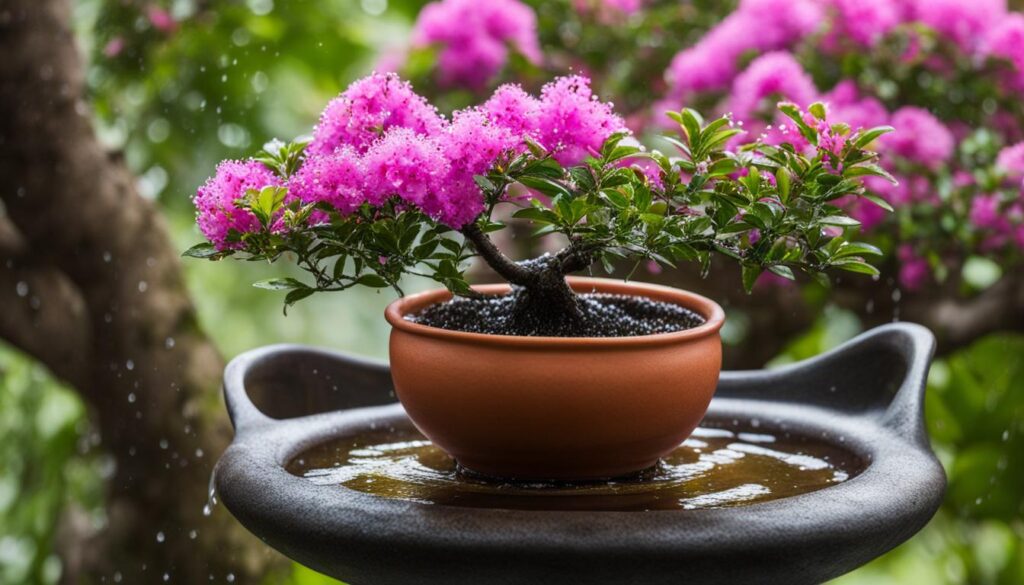
Proper watering is vital for the health and vigor of your crepe myrtle bonsai. By understanding the watering needs and using appropriate techniques, you can maintain the optimal moisture level and ensure the success of your bonsai tree.
During the growth period, crepe myrtle bonsai requires frequent watering to prevent drying out. The soil should be kept consistently moist, but be careful not to overwater and make it waterlogged.
In winter, when the tree is dormant, reduce watering to avoid over-watering. It is important to strike a balance and provide the right amount of water during different seasons.
To effectively water your crepe myrtle bonsai, follow these watering techniques:
- Before watering, check the moisture level of the soil by inserting your finger about an inch deep. If it feels dry, it’s time to water your bonsai.
- Water your crepe myrtle bonsai thoroughly until water comes out of the drainage holes at the bottom of the pot.
- Avoid splashing water on the foliage to prevent fungal diseases.
- Consider using a watering can with a narrow spout or a spray bottle to control the amount of water and target the root zone effectively.
By following these watering techniques and paying attention to the moisture needs of your crepe myrtle bonsai, you can help ensure its healthy growth and longevity.
Fertilizing Your Crepe myrtle Bonsai Tree

Proper fertilization is essential to ensure the healthy growth and development of crepe myrtle bonsai. By providing the necessary nutrients, you can support your bonsai’s overall health and vitality. Here are some fertilizing tips to keep your crepe myrtle bonsai thriving:
- Use a balanced liquid fertilizer: During the growing season, apply a balanced liquid fertilizer every two weeks. This will provide your bonsai with the essential nutrients it needs for healthy growth. Be sure to follow the manufacturer’s instructions for proper dilution ratios.
- Consider using solid organic fertilizer: In addition to liquid fertilizer, you can also use a solid organic fertilizer to promote healthy growth. Apply the organic fertilizer according to the instructions provided, taking care not to over-fertilize.
- Understand the fertilizing needs: It is important to understand the specific fertilizing needs of crepe myrtle bonsai. Different bonsai varieties may have slightly different requirements, so it’s essential to research and follow the recommended guidelines for your specific tree.
Remember to fertilize your crepe myrtle bonsai consistently and in moderation. Over-fertilization can lead to nutrient burn and other issues. By following these fertilizing tips, you can provide your bonsai with the necessary nutrients for healthy growth and beautiful blooms.
Pruning and Shaping Techniques for Crepe myrtle Bonsai
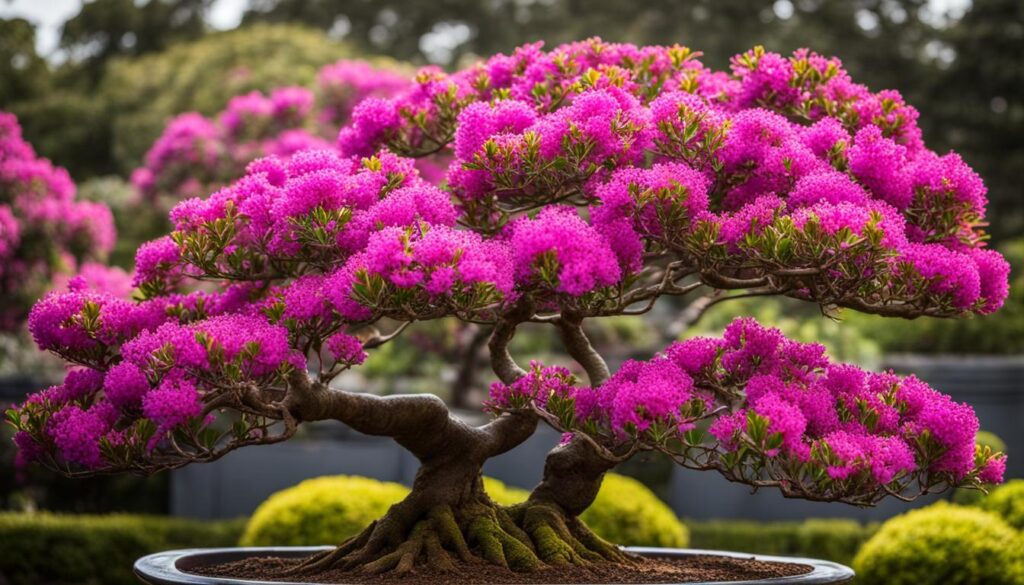
Pruning and shaping are essential techniques for maintaining the desired form and aesthetic appeal of your crepe myrtle bonsai. By carefully applying these techniques, you can create a visually appealing bonsai tree that captures the essence of the crepe myrtle species.
Pruning should be performed at the end of the summer season to encourage bud production for the following year. It involves selectively removing branches and foliage to refine the overall shape of the tree and maintain its miniature size. However, it is crucial to exercise caution and avoid damaging the beautiful bark of the crepe myrtle bonsai while pruning.
For shaping purposes, wiring can be used to guide the growth of the tree and create the desired artistic form. The wire is carefully wrapped around the branches and trunk, gently bending them into the desired shape. However, it is important to take precautions and avoid applying too much pressure or leaving the wire on for an extended period, as it can cause injury to the tree.
If you prefer an alternative approach to wiring, guy-wires can be utilized to shape the crepe myrtle bonsai. These wires are attached to the branches and trunk, gently pulling them in the desired direction. Guy-wires provide a more flexible and less intrusive method of shaping the bonsai tree.
Understanding the proper pruning and shaping techniques is crucial for achieving a visually appealing crepe myrtle bonsai. By practicing these techniques with care and precision, you can transform your bonsai tree into a miniature masterpiece that reflects the natural beauty of its larger counterpart.
Repotting Essentials for a Healthy Crepe myrtle Bonsai
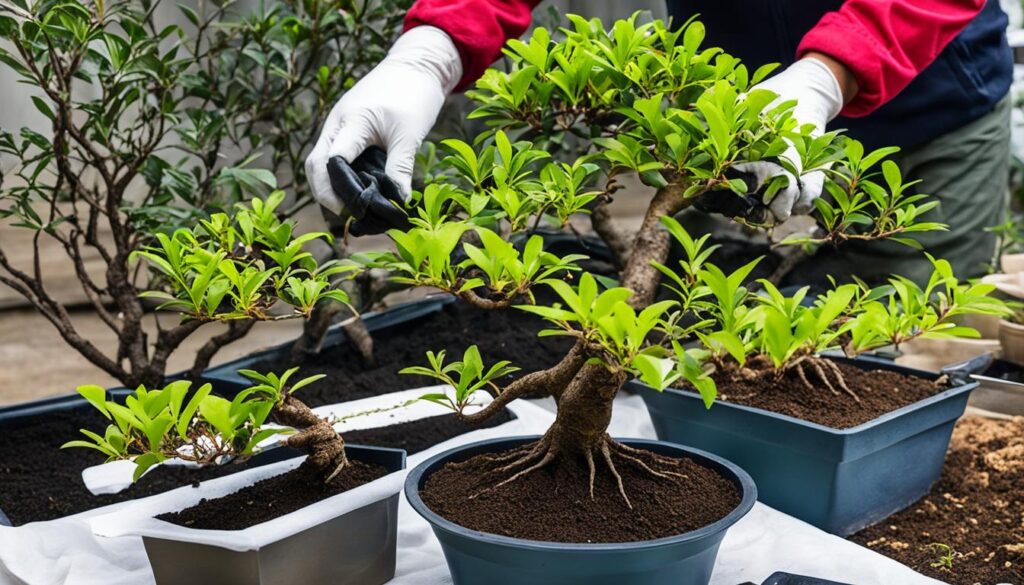
Repotting plays a crucial role in maintaining the health and vitality of your crepe myrtle bonsai. It is recommended to repot your bonsai every two to three years to ensure optimal growth and development. Repotting provides an opportunity to refresh the soil, remove any excess roots, and promote root development in a suitable container.
When repotting your crepe myrtle bonsai, it is important to use a well-draining soil mix that includes organic ingredients. This helps provide the necessary nutrients and promotes healthy growth. Consider using a mixture of Akadama, pumice, and organic compost to create an ideal growing medium.
Check out our complete article on Bonsai soil
To begin the repotting process, gently remove the bonsai from its current container. Carefully prune any circling or compacted roots, ensuring that the root ball is not excessively disturbed. Trim any roots that are too long or damaged, and ensure there is enough space for new root growth.
Prepare the new pot by adding a layer of fresh soil at the bottom, creating a mound in the center to support the bonsai’s root system. Place the bonsai on the mound, spreading out the roots evenly. Fill the pot with the prepared soil mix, ensuring that the roots are covered and held securely in place.
After repotting, water the bonsai thoroughly to settle the soil and eliminate air pockets. Place the bonsai in a sheltered area where it can recover from the repotting process. Protect it from direct sunlight and monitor its watering needs closely during this period.
Remember to mark the date of repotting on your calendar to keep track of when the next repotting should occur. This will help ensure that your crepe myrtle bonsai stays healthy and continues to thrive.
Methods of Propagating Crepe myrtle Bonsai
Propagating crepe myrtle bonsai is an exciting and rewarding process that allows you to grow new trees and expand your collection. There are two primary methods of propagation: starting from seeds and growing from cuttings. Each method has its own advantages and requirements, so let’s explore them in detail:
Starting From Seeds
If you have patience and enjoy watching the growth process from the very beginning, starting crepe myrtle bonsai from seeds is a great option. Here’s a step-by-step guide to help you get started:
- Collect ripe seeds from a healthy crepe myrtle tree.
- Remove the seeds from their protective capsules.
- Soak the seeds in water overnight to break their dormancy and improve germination.
- Fill a seed starting tray with a well-draining soil mix.
- Plant the seeds about 1/4 inch deep in the soil.
- Keep the soil consistently moist, but avoid overwatering.
- Place the tray in a warm and brightly lit area, preferably with temperatures around 70-75°F (21-24°C).
- Germination can take anywhere from a few weeks to a few months. Be patient and provide the necessary care.
- Once the seedlings have developed a few pairs of true leaves, you can transplant them into individual pots.
- Continue caring for the seedlings as they grow, providing adequate sunlight, watering, and fertilization.
- Over time, your seedlings will mature into beautiful crepe myrtle bonsai trees.
Growing From Cuttings
If you prefer a faster and more reliable method of propagation, growing crepe myrtle bonsai from cuttings is the way to go. Here’s how you can do it:
- Take a cutting from a healthy crepe myrtle tree in late spring or early summer.
- Choose a stem that is about 4-6 inches long and has several leaf nodes.
- Remove the lower leaves, leaving only a few at the top.
- Dip the cut end of the cutting in a rooting hormone to promote root development.
- Prepare a well-draining soil mix in a small pot or container.
- Make a hole in the soil and insert the cutting, ensuring that at least two leaf nodes are buried in the soil.
- Water the cutting thoroughly and place it in a warm and bright location.
- Maintain high humidity around the cutting by covering it with a plastic bag or using a misting system.
- Roots should start developing within a few weeks.
- Once the cutting has developed a strong root system, it can be transplanted into a larger pot or bonsai container.
- Continue caring for the young plant, providing appropriate watering, sunlight, and fertilization.
- With time and proper care, your cutting will transform into a magnificent crepe myrtle bonsai.
Propagation is a fascinating aspect of bonsai cultivation, allowing you to create new trees while enjoying the nurturing process. Whether you choose to start from seeds or grow from cuttings, understanding the propagation methods and following the recommended steps will increase your chances of success. So, roll up your sleeves, get your hands dirty, and embark on the journey of propagating your own crepe myrtle bonsai!
| Propagation Method | Advantages |
|---|---|
| Starting From Seeds | Opportunity to witness the entire growth processPotential for unique variations in new seedlingsCost-effective compared to purchasing mature bonsai |
| Growing From Cuttings | Quicker method with higher success ratesAbility to replicate the characteristics of the parent treeGreater control over the bonsai’s form and style |
Pests and Diseases Affecting Crepe myrtle Bonsai
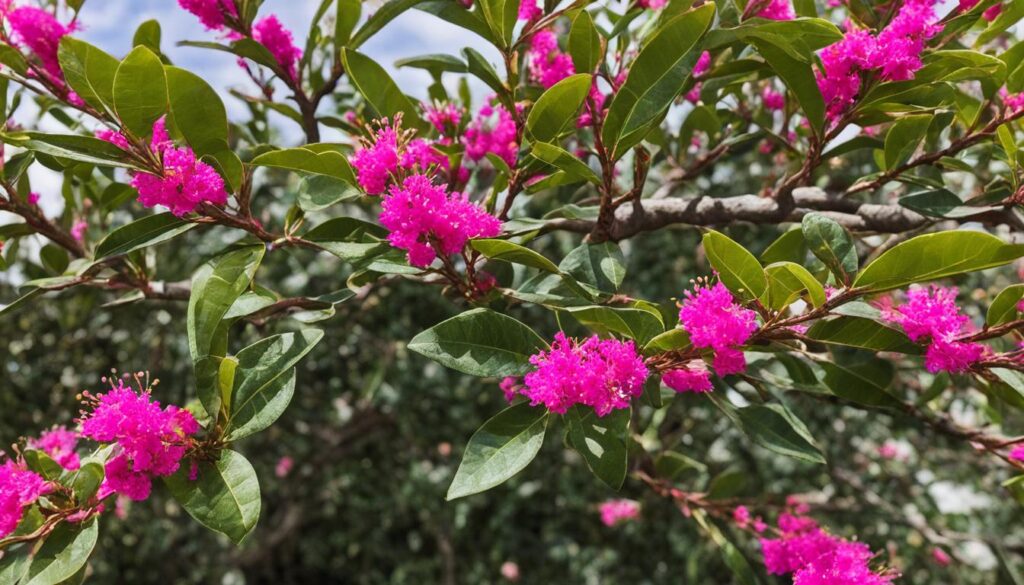
Crepe myrtle bonsai, like any other plant, can be vulnerable to pests and diseases. Taking prompt action and implementing preventive measures can help keep your crepe myrtle bonsai healthy and thriving. Common pests that may affect crepe myrtle bonsai include aphids, scale, mealybugs, and whiteflies. These pests can cause damage to the leaves, stems, and flowers of your bonsai tree.
You can control these pests using appropriate insecticides or physical methods. Regularly inspect your bonsai tree for any signs of infestation and take necessary steps to eliminate the pests. In case of severe infestations, consult with a professional or an experienced bonsai enthusiast for guidance.
Mildew is a potential disease that can affect crepe myrtle bonsai. It is a type of fungal infection that can cause white powdery patches on the leaves and stems. To address mildew, you can use specific fungicides that are suitable for crepe myrtle bonsai. Always follow the instructions provided on the fungicide label and apply it as directed.
Prevention is key when it comes to pests and diseases in crepe myrtle bonsai. Maintain good bonsai tree hygiene by regularly removing any fallen leaves or debris that can harbor pests or fungal spores. Ensure proper air circulation around the bonsai tree and avoid overwatering, as excess moisture can create conditions favorable for pests and diseases.
By understanding and being proactive in dealing with common pests and diseases, you can protect the health and beauty of your crepe myrtle bonsai. Regular monitoring, prompt action, and practicing good bonsai care techniques will contribute to the long-term success of your crepe myrtle bonsai.
“Taking prompt action and implementing preventive measures can help keep your crepe myrtle bonsai healthy and thriving.”
Crepe myrtle Bonsai Seasonal Care Tips
Proper seasonal care is crucial for the optimal health and growth of your crepe myrtle bonsai tree. By adjusting watering frequency, fertilizing schedules, pruning techniques, and positioning according to the specific needs of each season, you can ensure that your bonsai thrives and flourishes. Here are some valuable seasonal care tips to help you provide the best care and support for your crepe myrtle bonsai.
Spring: As the warmer months approach, increase your watering frequency to keep the soil consistently moist. This is a crucial time for growth, and providing adequate water will promote the development of vibrant flowers and lush foliage. Additionally, consider applying a balanced liquid fertilizer to provide the necessary nutrients for healthy growth and blooming.
Summer: During the hot summer months, it’s important to protect your crepe myrtle bonsai from intense sunlight and high temperatures. Provide partial shade to prevent leaf scorch and ensure the tree’s well-being. Keep a close eye on soil moisture levels and adjust your watering routine accordingly, taking care not to overwater.
Fall and Winter: As the weather starts to cool down, gradually reduce the frequency of watering to avoid over-saturating the soil. This will help prepare your bonsai for dormancy during the winter months. Pruning can be done during fall to shape the tree and remove any dead or damaged branches. If you live in a region with freezing temperatures, it’s important to transfer your bonsai to a protected area or use suitable insulation to shield it from cold winds and frost.
By following these seasonal care tips for your crepe myrtle bonsai, you’ll create optimal growing conditions and ensure the long-term health and beauty of your tree. Remember to always observe the unique requirements of each season and make adjustments accordingly. Your dedication and attention to detail will be rewarded with a thriving and stunning crepe myrtle bonsai.

